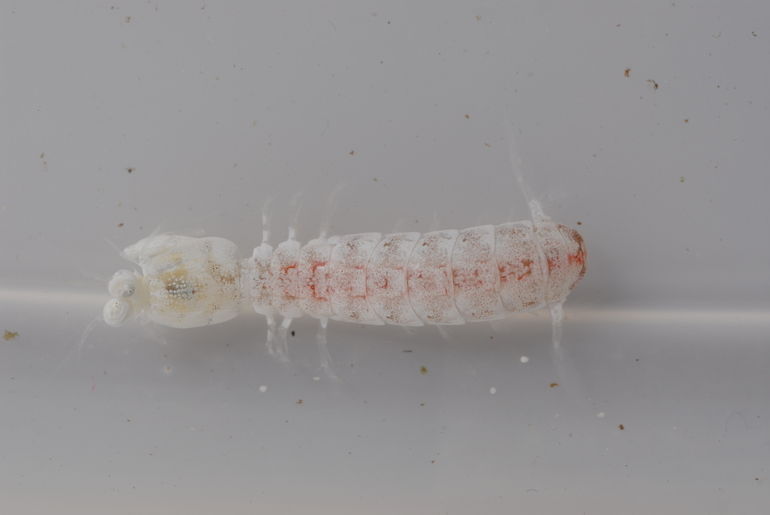Invasion History
First Non-native North American Tidal Record: 1999First Non-native West Coast Tidal Record:
First Non-native East/Gulf Coast Tidal Record: 1999
General Invasion History:
The mantis shrimp Pullosquilla litoralis is native to the tropical Indian Ocean, including Madagascar and the Aldabra Islands, as well as, the West Pacific from Sulawesi, Indonesia, east to the Marquesas, south to Australia, and north to Guam (Manning 1978; Ahyong and Erdmann 2003; US National Museum 2011). It inhabits sandy areas in the vicinity of coral reefs, but has also been found in seagrass beds (Manning 1978).
North American Invasion History:
Invasion History on the Gulf Coast:
In 1999, a single specimen of Pullosquilla litoralis was captured at Aquarius Undersea Research Station, Key Largo, Florida, on Conch Reef, in the Gulf of Mexico (USNM 307240, US National Museum of Natural History 2009, identified by S. Ahyong, University of Victoria, Melbourne, Australia). We know of no further records of this mantis shrimp from continental US waters. Possible vectors include ballast water, the aquarium industry, or (less likely) scientific research. Web searches indicate that a few aquarists keep mantis shrimps, but most regard them as pests because of their ability to kill fish. They do enter marine aquaria with 'live rock', pieces of imported coral, covered and riddled with living biota. According to web references, Pullosquilla litoralis has been used as an experimental animal in the US for studies of its social behavior and visual adaptations.
Description
Mantis shrimps (order Stomatopoda) are crustaceans that are somewhat lobster-like, but have many features which distinguish them from the order Decapoda. Their compound eyes are prominent and stalked. The carapace only covers the rear part of the head. They have five pairs of walking legs, but the second pair is developed into a powerful claw, with a single spear-like or spine-bearing movable finger, which folds into a groove on the large penultimate segment (propodus). The whole claw resembles a jackknife and is used to spear or seize prey. The three remaining pairs of walking legs are weakly developed. The pleopods, under the abdomen, are well-developed and bear feathery gills. The telson is broad, and flanked by large uropods (Barnes 1983).
The Indo-Pacific mantis shrimp Pullosquilla litoralis has a smooth, flattened, loosely articulated body. The rostral plate is triangular and lacks anterior spines. The carapace is strongly narrowed anteriorly, and lacks keels or spines, as do the thoracic segments. The movable finger of the claw has 10-13 teeth. The propodus is thick and bears four movable spines. The telson is broader than it is long, with the dorsal surface produced into a 'false eave' which covers much of the marginal armor of the telson, including 6-8 lateral teeth, and numerous (12-22) posterior and denticles. The proximal segment of the uropodal exopod has three movable spines laterally and two to five, usually three, stiff setae on the inner distal angle. Animals mature at about 13 mm and reach 18 mm total length (Manning 1978). Color is not given in Manning's description. Based on photos in the CalPhotos database (http://calphotos.berkeley.edu/), the color of the carapace is greenish brown, with small white spots, while the median region of the thorax is often reddish, but also with numerous small white spots. Lighter, grayish bands run along the joints between thoracic segments.
Larval development of this species has not been described. A picture of the larva of the mantis shrimp Squilla empusa, showing typical stomatopod features, is given in Barnes (1983).
Taxonomy
Taxonomic Tree
| Kingdom: | Animalia | |
| Phylum: | Arthropoda | |
| Subphylum: | Crustacea | |
| Class: | Malacostraca | |
| Subclass: | Hoplocarida | |
| Order: | Stomatopoda | |
| Suborder: | Unipeltata | |
| Superfamily: | Lysiosquilloidea | |
| Family: | Nannosquillidae | |
| Genus: | Pullosquilla | |
| Species: | litoralis |
Synonyms
Potentially Misidentified Species
Common Rock Mantis Shrimp
Lysiosquilla scabricauda
Scaly-tailed Mantis Shrimp, common in Florida
Pseudosquilla ciliata
Ciliated False Squilla
Squilla empusa
Common Mantis Shrimp, large temperate mud-dwelling form
Ecology
General:
Mantis shrimp typically live in burrows or crevices. Pullosquilla litoralis usually lives in monogamous pairs in a U-shaped burrow. After mating, the female carries and tends a spherical egg mass, from which planktotrophic larvae hatch. The larvae may spend several months in the plankton (Barnes 1983). Adult P. litoralis inhabit sandy patches adjacent to coral reefs and seagrass beds (Manning 1978; Ahyong and Erdmann 2003).
Food:
Fishes, benthic invertebrates
Trophic Status:
Carnivore
CarnHabitats
| General Habitat | Coral reef | None |
| General Habitat | Unstructured Bottom | None |
| General Habitat | Grass Bed | None |
| Salinity Range | Euhaline | 30-40 PSU |
| Tidal Range | Subtidal | None |
| Vertical Habitat | Endobenthic | None |
| Vertical Habitat | Epibenthic | None |
Tolerances and Life History Parameters
| Broad Temperature Range | None | Tropical |
| Broad Salinity Range | None | Euhaline |
General Impacts
Outside its native range, Pullosquilla litoralis is known only from one specimen in the Florida Keys, and has no known ecological or economic impacts.Regional Distribution Map
Non-native
Native
Cryptogenic
Failed
Occurrence Map
References
Ahyong, Shane T.; Erdmann, Mark W. (2003) The stomatopod Crustacea of Guam, Micronesica 35-36: 315-352Barnes, Robert D. (1983) Invertebrate Zoology, Saunders, Philadelphia. Pp. 883
Manning, Raymond B. (1978) New and rare Stomatopod Crustacea from the Indo-West-Pacific region, Smithsonian Contributions to Zoology 264: 1-36
U.S. National Museum of Natural History 2002-2021 Invertebrate Zoology Collections Database. http://collections.nmnh.si.edu/search/iz/
